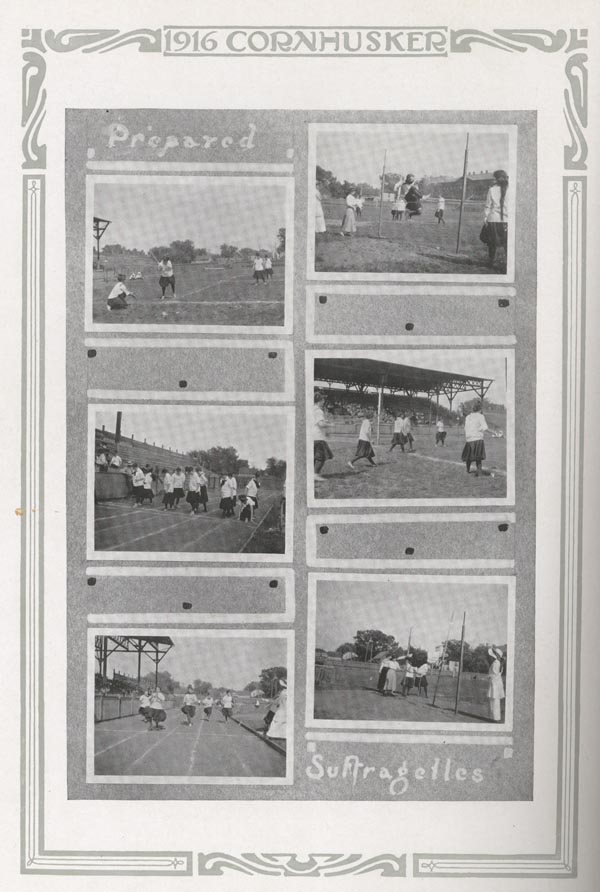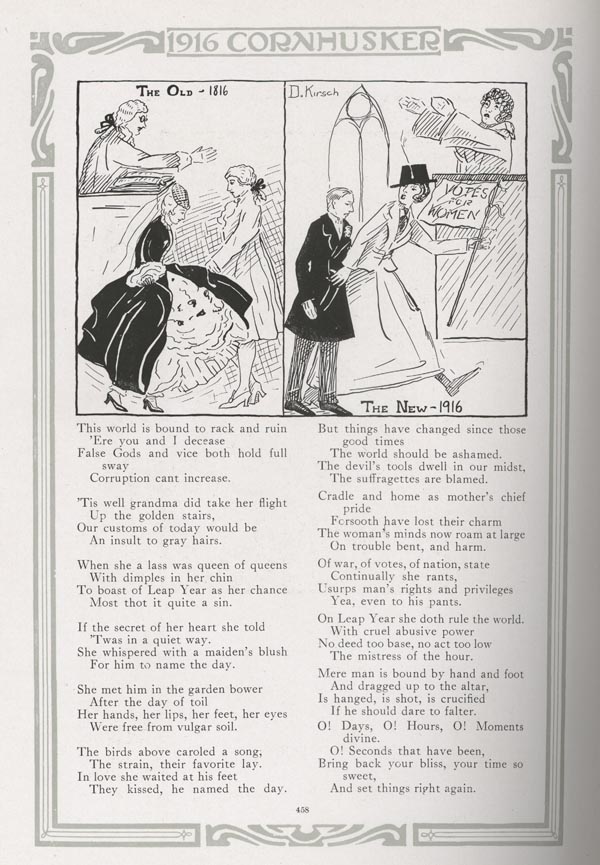Projects
Project Editor: Beth Klopping, English 418/818, Fall 2005
WOMEN IN SPORTS
In Society
The issue of women's sportswear did not stay inside the walls of the gymnasiums or the pages of the yearbooks. Women wearing bloomers (even if they were worn under skirts) and playing sports (even if they were away from the eyes of men) were concepts that exploded politically. Because, after all, these issues were creating changes that rippled outside the university.
For example, this page appeared as page 196 in the 1916 yearbook:

Featuring six rather unique photographs of women actively competing, two words also appear on the page. "Prepared," is shown in the upper-left corner, and "Suffragettes" appears in the lower-right. Using a term such as "Suffragettes" within the context of sports, seems to indicate a recognition, on the part of the editors, that women's athletics and women's rights were inseparably intertwined. This is proven to be true, as is shown on page 458 of the same yearbook.

The poem reads as follows:
This world is bound to rack and ruin
'Ere you and I decease
False Gods and vice both hold full sway
Corruption cant increase.
|
'Tis well grandma did take her flight
Up the golden stairs,
Our customs of today would be
An insult to gray hairs.
|
When she a lass was queen of queens
With dimples in her chin
To boast of Leap Year as her chance
Most thot it quite a sin.
|
If the secret of her heart she told
'Twas in a quiet way.
She whispered with a maiden's blush
For him to name the day.
|
She met him in the garden bower
After the day of toil
Her hands, her lips, her feet, her eyes
Were free from vulgar soil.
|
The birds above caroled a song,
The strain, their favorite lay.
In love she waited at his feet
They kissed, he named the day.
|
But things have changed since those good times
The wold should be ashamed.
The devil's tools dwell in our midst,
The suffragettes are blamed.
|
Cradle and home as mother's chief pride
Forsooth have lost their charm
The woman's minds now roam at large
On trouble bent, and harm.
|
Of war, of votes, of nation, state
Continually she rants,
Usurps man's rights and privileges
Yea, even to his pants.
|
On Leap Year she doth rule the world.
With cruel abusive power
No deed too base, no act too low
The mistress of the hour.
|
Mere man is bound by hand and foot
And dragged up to the alter,
Is hanged, is shot, is crucified
If he should dare to falter.
|
O! Days, O! Hours, O! Moments divine.
O! Seconds that have been,
Bring back your bliss, your time so sweet,
And set things right again.
|
|
Clearly, there was more to deal with, here, than the length or cut of the clothing women athletes wore. What women wore reflected their place in the world, and the fact that they were changing these rules scared those around them who wished to conserve the status quo. For some athletes, participation in sports was a sort of emotional emancipation, and some worried that women were tasting this freedom and would soon demand more.
"Society's disapproval of women wearing bifurcated sports garments was loud, irrational, and generally full of emotion. The majority of the protests were related to modesty because customs pertaining to the differentiation of the sexes were being broken." (Grossbard, 62)
A BIT OF HISTORY
Amelia Bloomer stands at the forefront of this controversy. Although the Turkish-style pants, called bloomers, were named after her, this naming was unintentional on her part. Bloomer published and edited The Lily, a newspaper she began in 1849, and that eventually promoted the Dress Reform Movement.
Elizabeth Smith Miller apparently appeared in front of Bloomer, dressed in a (then) very daring outfit. Most daring were the full Turkish trousers she wore under a short skirt. Bloomer herself appeared in The Lily wearing this new costume in 1851. All of a sudden, people were referring to these pants as bloomers, despite Bloomer's protests that she had nothing to do with their creation. In reference to the letters Bloomer received on the new style, she wrote:
"Some praised and some blamed, some commented and some ridiculed and condemned. 'Bloomerism,' 'Bloomerites,' and 'Bloomers' were the headings of many an article, item and squib; and finally some one—I don't know to whom I am indebted for the honor—wrote the 'Bloomer Costume,' and the name has continued to cling to the short dress in spite of my repeatedly disclaiming all right to it and giving Mrs. Miller's name as that of the originator or the first to wear such a dress in public." (Bloomer, 68)
After this, subscription to The Lily shot up, hundreds of letters came in about the Bloomer Costume. Bloomer couldn't stop wearing the costume if she'd wanted to. Instead, she used this publicity to promote her goals within the Dress Reform Movement. In her words:
"We all felt that the dress was drawing attention from what we thought of far greater importance—the question of woman's right to better education, to a wider field of employment, to better remuneration for her labor, and to the ballot for the protection of her rights. In the minds of some people, the short dress and woman's rights were inseparably connected." (Bloomer, 70)
Unfortunately, Bloomer herself didn't live to see these bloomers at the height of their popularity. But, in 1955, C. Neilson Gattey and Z. Bramley -Moore published "The Birth of the Bloomer: A Comedy in One Act." Centered around Bloomer's first encounter with the costume worn by Miller, the play emphasizes the difficulties—even humor—involved in dressing in the "appropriate" attire at the end of the nineteenth century. The female characters stumble in their full skirts and petticoats, and Bloomer herself exclaims, "We will never be able to compete with men so long as we are hampered by our clothes." (11) Which was, truly, the heart of the issue.
|

